March 2013
Sat 2nd: The Story So Far (5)
Wed 6th: No hope
Wed 6th: Feb finished
Wed 8th: Mixing it up
Wed 11th: Charge!
Wed 13th: Miniature
Fri 29th: Easing Into Exmouth
Fri 29th: Illusion
Sat 30th: Apocolypse Averted
Sat 30th: Hack Attack I
Sun 31st: No Retreat
Sun 31st: Hack Attack II
Sat 2nd: The Story So Far (5)
Division 1
| H C Kings
| 6
| 5
| 0
| 1
| 10
| | Stafford A
| 4
| 3
| 1
| 0
| 7
| | Newcastle A
| 6
| 2
| 0
| 4
| 4
| | Cheddleton A
| 4
| 1
| 1
| 2
| 3
| | Alsager A
| 4
| 0
| 0
| 4
| 0
|
|
Division 2
| Cheddleton C
| 8
| 6
| 2
| 0
| 14
| | Cheddleton B
| 7
| 3
| 3
| 1
| 9
| | Newcastle B
| 7
| 4
| 1
| 2
| 9
| | H C Knights
| 9
| 3
| 1
| 5
| 7
| | Macclesfield
| 9
| 3
| 1
| 5
| 7
| | H C Rooks
| 8
| 0
| 2
| 8
| 2
|
|
The significant result in division one in February was Stafford's defeat of Cheddleton, which all but reduces the title to a two horse race between Stafford and Holmes Chapel Kings.
At the top of division two Cheddleton C have extended their unbeaten start to the season by a further two matches, and now need just a single point from their remaining two matches to secure at least a share in the title, two to win outright. Macclesfield continue their improvement, but it is too late for them to reach the top.
Division 3
| Cheddleton E
| 13
| 7
| 2
| 4
| 16
| | Cheddleton D
| 12
| 7
| 1
| 4
| 15
| | Fenton A
| 12
| 6
| 2
| 4
| 14
| | Stafford B
| 11
| 7
| 0
| 4
| 14
| | Newcastle D
| 13
| 5
| 3
| 5
| 13
| | Meir A
| 13
| 5
| 2
| 6
| 12
| | Kidsgrove
| 10
| 4
| 3
| 3
| 11
| | Alsager B
| 12
| 5
| 0
| 7
| 10
| | H C Pawns
| 12
| 4
| 1
| 7
| 9
| | Newcastle C
| 14
| 3
| 2
| 9
| 8
|
|
Division 4
| Fenton B
| 11
| 8
| 3
| 0
| 19
| | Cheddleton F
| 12
| 7
| 3
| 2
| 17
| | Cheddleton G
| 11
| 7
| 2
| 2
| 16
| | Alsager D
| 13
| 5
| 4
| 4
| 14
| | Alsager C
| 11
| 5
| 3
| 3
| 13
| | Meir B
| 12
| 5
| 3
| 4
| 13
| | Meir C
| 10
| 3
| 2
| 5
| 8
| | Fenton C
| 12
| 3
| 2
| 7
| 8
| | Newcastle E
| 12
| 1
| 2
| 9
| 4
| | H C Tiny Pawns
| 12
| 1
| 2
| 9
| 4
|
|
In contrast to division two, the likely outcome of division three is still as clear as mud. last month I wrote that the most likely candidiates for the top are Cheddleton E and Stafford B, but each dropped points during the month, to allow Cheddleton D and Fenton A in particular into the hunt. Kidsgrove have some catching up to do, their only February match having been postponed whilst others were fitting in two or even three matches.
Plenty of matches played in division four over the last month, with Fenton B moving into poll position in their battle with the Cheddleton twins thanks to picking up seven points in four games played. The Alsager combines now look well placed to be declared the best of the rest, whilst Newcastle E and the Tiny Pawns are still locked in their private battle for the wooden spoon, the gap to the teams above them having doubled to four points over the month.
Newcastle's Open Cup team had a second board count victory to reach the final in which they will visit Cheddleton. Fenton will host the Perry final after defeating Meir, their visitors to be Newcastle as Cheddleton suffered a mix-up over dates.
Assuming I haven't overlooked anything there was only one defaulted board last month, with Rooks visiting Cheddleton C a man short.
March features the Newcastle Mini Congress, the semi-finals of the Intermediate Cup and the third of the strong players GPs as well as a string of league matches. My most confident prediction is that the third division will be unresolved come Easter.
comment on this article
Wed 6th: No hope
Wandered down to the bridge club for our home match against Stafford A. Entered the match room and did a quick gulp. The Stafford card shows a five man team with total grade 950. That's 30 points a board we're conceding. Chances don't seem good, but that's no excuse for my subsequent play of a man totally without hope. We join the game after an uneventful opening. RR has probably lost white's natural edge, but is otherwise OK

|
| RR v Malcolm Armstrong after 11 ... Qe7
|
r1b1r1k1/pp1nqppp/2pb1n2/3p4/3P4/1PN1PN2/PBQ1BPPP/R4RK1 w
Rooks on c1 and d1 looks natural, but persuaded myself I wanted one on e1. Also though of Nh4 to be followed by Nf5 if allowed, which is perhaps best of the lot.
12 Rfe1 Ne4, 13 Nxe4 not wanting to allow support from the other knight hopping into f6
13 ... dxe4, 14 Nd2 Nf6, 15 Nc4 Bc7, 16 a3 I ask you, what sort of move is that? Am I really going to play b4 and play a minority attack on the queenside? Besides what's wrong with Ba3? That would delay his wish to line up artillery against h2.
16 ... Ng4, 17 Bxg4 (Fearful that h3 would lead to a later bishop sac by black. Definitely in wimpy coward mode.)
17 ... Bxg4, 18 Ne5 Bc8, 19 Rac1 Chasing the glimmer of exchanging material, but continually chopping and changing plans is no way to play he game. My original thoughts were to play f4 which if taken frees my central pawns, and if not reduces his dark-squared bishop's influence.
19 ... f6
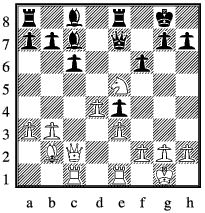
|
| RR v Malcolm Armstrong after 19 ... f6
|
r1b1r1k1/ppb1q1pp/2p2p2/4N3/3Pp3/PP2P3/1BQ2PPP/2R1R1K1 w
The sensible move now is Nc4 as it can reach f1 before the black queen can line up against h2. However for once RR follows the same plan for two moves in a row, chasing the glimmer of exchanges spotted before.
20 Nxc6 Qd6
(In fact black can play 20 ... bxc6, 21 Qxc6 Bb8 as white would regret taking the rook on a8)
21 Ne5 Re7, 22 g3 Horrible. Opening up all sorts of holes around the king. Taking the e-pawn must be better or even f4. It's now just a case of how quickly white can lose.
22 ... fxe5, 23 dxe5 Qg6, 24 Qc5 Rf7, 25 Qd5 Qf5, 26 Rf1 Bb6
27 Bd4 making life easy by blocking off the queen's useful retreats.
27 ... Be6, 28 Qb5 Qf3 I've had enough 0-1
Not RR's finest hour.
comment on this article
Wed 6th: Feb finished
Have just uploaded my last two games from February to complete my diary for that month.
Wed 8th: Mixing it up
Cheddleton A away were next up, and RR duly found himself sitting down with black against Simon Edwards. We join the game with Simon having decided it was time for some proper central action.
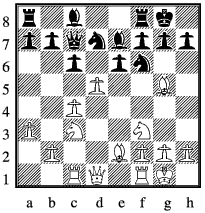
|
| Simon Edwards v RR after 13 d5
|
r1b2rk1/ppqnbppp/2p1pn2/3P2B1/2P5/P1N2N2/1P2BPPP/2RQ1RK1 b
For reasons that are not entirely clear I rejected Ne5 or Nb6 in favour of e5, presumably hoping that a further push of this pawn might be possible later.
13 ... e5, 14 b4 A relief, as after I had pushed e5 I became concerned about my prospects after Ne4 - can I stop Simon getting in d6?
14 ... Re8 Protecting the bishop negates the threats posed by Ne4.
15 dxc6 bxc6, 16 Bd3
RR's position, which he has taken considerable time to acquire, is tenable but passive, not ideal when facing a stronger player. Hence he decided to offer a pawn for some crude activity, fully aware that a piece sac might be necessary later. Simon was up for it:
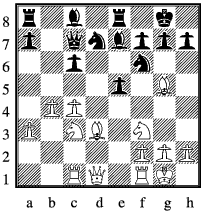
|
| Simon Edwards v RR after 16 Bd3
|
r1b1r1k1/p1qnbppp/2p2n2/4p1B1/1PP5/P1NB1N2/5PPP/2RW1RK1 b
16 ... Ng4, 17 Bxe7 Rxe7, 18 Bxh7+ Kxh7, 19 Ng5+ Kg8, 20 Qxg4 That's the end of the pawn losing combination. Now to see whether my pieces have been freed up enough to make any worthwhile threats against h2.
20 ... Nf6, 21 Qh4 Bf5, 22 Nge4 Nxe4, 23 Nxe4 Re6, 24 Nc5 Rh6
25 Qg5 e4, 26 Qg3 Qe7, 27 Rfe1 g6, 28 Nd3 Kg7, 29 Qe5+ Qxe5
30 Nxe5 Rah8, 31 h3 Surprised to find myself down to less than three minutes, so rather than spending time working out whether g5 might get me anywhere, went straight in with the sac.
31 ... Bxh3, 32 gxh3 Rxh3, 33 Nxc6 Rh1+, 34 Kg2 R1h2+, 35 Kg3 Didn't expect that. Thought it would be
Kf1 e3, not that I think that leads to somewhere good for me.
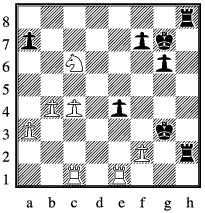
|
| Simon Edwards v RR after 35 Kg3
|
7r/p4pk1/2N3p1/8/1PP1p3/P5K1/5P1r/2R1R3 b
Annoyingly, whilst my first reaction was R8h4, which indeed causes considerable problems for white, there even being real mate threats. Certainly it gives me good chances of escaping with a draw. Unfortunately I elected to play f5 first. Despite the Fiscaher time controls I was moving into panic mode, and blundered a rook a few moves later:
35 ... f5, 36 Kf4 Rxf2+, 37 Ke5 Re8+, 38 Kd5 Ra2, 39 Rg1 Rxa3
40 Ne5 Ra5+ 1-0
comment on this article
Wed 11th: Charge!
Sometimes pawns seem to have a collective momentum of their own, rushing up in the board in gay abandon. Whilst this can lead to a rout of the opposition, it can also leave one dangerously exposed to having one's position undermined. RR's game against Dave Price from Holmes Chapel featured carefree white pawns given a holiday from their normal defensive duties.
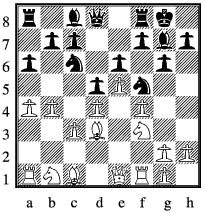
|
| RR v Dave Price after 11 Qe1
|
r1bq1rk1/1pp2pb1/p1n1p1p1/3pPn2/PP1P1P2/2PB1N2/2PB1N2/6PP/RNB1QRK1 b
Dave's first attempt at undermining the pawns with d5 was ignored with the white e-pawn continuing to e5. His second attempt, f6, is bound to have some effect.
11 ... f6, 12 g4 Another pawn rushes up the beach.
12 ... Nh6 The black knight runs from the latest wave, but in the wrong direction. A positional deficit is about to become a material one.
13 exf6 Black wakes up too late. He now has the less than delightful choice of recapturing and setting up a fork, or retreating the bishop to h8, from where it may not escape for the rest of the game. Dave elects to capture.
13 ... Bxf6, 14 g5 (fork) Bxd4+, 15 Nxd4 Nxd4, 16 cxd4 Nf7
17 Nd2 Kg7, 18 Nf3 c6, 19 Bd2 b6, 20 Qh4 Rh8, 21 Ne5 The rest of the game turns into a show room for simple tactics. RR's g-pawn is not pinned against his queen as attempts to advance the black h-pawn are met with gxh6+.
21 ... Qc7, 22 Rac1 Bb7, 23 b5 the c-pawn is pinned
23 ... axb5, 24 Bxb5 still pinned
24 ... c5, 25 dxc5 bxc5, 26 Bc3 threaetening a discovered check
26 ... d4, 27 Bxd4 Sorry, the c-pawn is still pinned!
27 ... Kf8, 28 Bxc5+ with threats of discovered attack against the queen
28 ... Nd6, 29 Nxg6+ Did I tell you I like pins? This time its the h-pawn suffering.
29 ... Kf7, 30 Ne5+ Ke7, 31 g6+ I've run out of pins, so I'll try a discovered check instead.
31 ... Kf8, 32 Bxd6+ a fork of king and queen which deflects the queen from the defence of the seventh rank.
32 ... Qxd6, 33 Qf6+ 1-0
With apologies to Dave, who did see the humour in the situation. And to my h-pawn - I'll use you in an attack another day.
comment on this article
Wed 13th: Miniature
One might think that in a short game there is only enough room for one side to go wrong. Think again. For the third time this season RR sat down to play Roger Edwards, the previous two efforts being draws. This time the players combined to produce a line familiar to neither. Consequently much time was spent by both sides even getting through the first nine moves to reach the position shown in which white is (temporarily?) a pawn up but black has a lead in development.
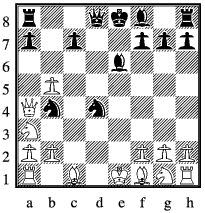
|
| Roger Edwards v RR
|
More decisions for Roger. Attack one of those pesky knights (which one?) or get on with some belated kingside development? Or even b6+? Decision made:
10 Bd2.
The b4 knight is now attacked twice. RR's turn to think. Ignore, retreat, or provide a second defender? What do you think? Go on, think before reading on. RR saw the best move, and the reasons behind it, but convinced himself it didn't work (wrong!) so instead came up with
10 ... Qd6
Over to Roger. By now he had a little over half an hour left. Not time trouble, but much thinking has already been done, with more to follow. Now what? Fearful that the line
11 Bxb4 Qxb4+, 12 Qxb4 Bxb4+, 13 Kd1 would lead to rook appearing on d8 with unpleasantness consequences for white, he selected a move he had rejected earlier.
11 Ne2 Clang!! Nd3+ 0-1 The white queen is not long for this world.
(11 Be2 would have left black ahead but not devastatingly so as say
11 ... Nxe2, 12 Nxe2 Nd3+ and white has the f1 square for his king.)
But backtrack a mo. Why was Qd6 wrong for black? Because Qh4 is better, as it creates threats of discovered attacks on the white queen. Try
10 ... Qh4, 11 Bxb4 Bxb4+, 12 Qxb4 Nf3+
or
10 ... Qh4, 11 0-0-0 Ne2+, 12 Kb1 (Bxe2 Nxa2+) Bf5+, 13 Ka1 Nc2+
or
10 ... Qh4, 11 Be2 Ndc2+, 12 Nxc2 Nd3+.
Hitting black's queen doesn't work for white either:
10 ... Qh4, 11 Nf3 Nxf3+ wins the knight as recapturing allows Nd3+ and
10 ... Qh4, 11 Qe4 is unfriendly.
So why did I think it wouldn't work? My brain retains no log of its thoughts on the matter.
comment on this article
Fri 29th: Easing Into Exmouth
Time for my annual pilgramage to Exmouth for the West of England Easter Congress. As usual I'd travelled down on the Thursday. After booking into my B & B I walked over the cliffs to Budleigh Salterton, having a meal there before returning to Exmouth by bus. Despite the extensive rain this winter in the south west, the path over the cliffs was much less muddy than I had feared; indeed the only patches worth worrying about could easily be by-passed. Consequently I was able to enjoy the scenery rather than watching my feet every step of the way.
There was only one other chess player, Paul Tew from Cardiff, staying at my lodgings for the weekend, so we had a civilized chat over breakfast, before making separate ways around the corner to the venue to discover we were drawn to play each other.
We join the game with RR considering his tenth move after the sort of typically nebulous opening he tends to play.
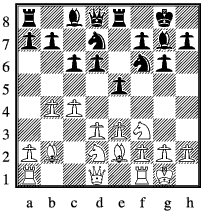
|
| RR v Paul Tew after 9 ... c6
|
r1bqr1k1/pp1n1pbp/2pp1np1/4p3/1PP5/3PPN2/PB1NBPPP/R2Q1RK1 w
Time to offer black the chance to give me doubled pawns, giving me his d6 pawn as a target in return.
10 Ne4 Nf8 Declining the offer
11 Qc2 d5, 12 Nxf6+ Bxf6, 13 cxd5 cxd5, 14 Rac1 d4, 15 e4 Reducing my future options. Better to redevelop the knight to e4 and the bishop to f3. Fortunately Paul didn't see fit to play Nf4 at any point, as that would have tied me down even more.
15 ... Ne6 16 Rfe1 Bd7 17 a4 Not proud of this - I'm hardly going to want to advance b5 in the immediate future.
17 ... Rc8, 18 Qb3 Qb6, 19 Rxc8 Rxc8, 20 Rc1 Rxc1+ Draw Offered
And accepted pronto - I do not like look of
21 Bxc1 Qc6, 22 Bb2 Qxa4 as I would be a clear pawn down with no hint of compensation.
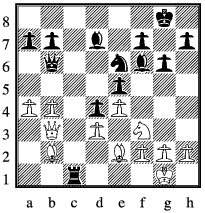
|
| RR v Paul Tew Final position
|
comment on this article
Fri 29th: Illusion
It was difficult to decide on a starting position for my report of my round 2 game against Tim Chapman, for the whole game was a slow motion effort, but I've decided to go from where my queen has just been kicked back to e8. I've found myself on the black side of these sorts of positions quite often, and although I am sure white is better for his space advantage, it is amazing how often his plus disappears.
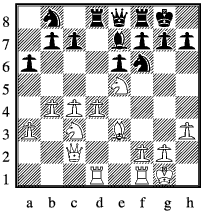
|
| Tim Chapman v RR after 16 ... Qe8
|
1n1rqrk1/1pp1bppp/p3pn2/4N3/1PPP4/P1N1B2P/2Q2PP1/3R1RK1 w
17 Ne4 c6, 18 f4 Nxe4, 19 Qxe4 f5 I used to be afraid of this move, leaving myself witha permanent backward pawn on a half open file, but I'm learning that other factors can outweigh this disadvantage.
20 Qc2 Nd7, 21 Qe2 Nf6, 22 Rc1 Ne4, 23 Qf3 Bf6
24 Rfd1 Rc8, 25 Kh2 Rc7, 26 g3 Bxe5, 27 dxe5 Rff7
28 Bb6 Rcd7, 29 Qe3 Rxd1, 30 Rxd1 Rd7, 31 Rd4 Kf7
32 a4 Qc8, 33 g4 g6, 34 Kg2 Ke8, 35 Kf3
Much manoeuvring, some of it doubtless inferior, leaves me in a position where I can disrupt his queenside pawns and so hopefully secure a superior endgame
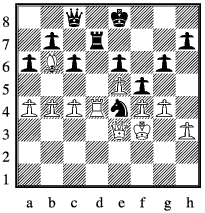
|
| Tim Chapman v RR after 35 Kf3
|
2q1k3/1p1r3p/pBp1p1p1/4Pp2/PPPRnPP1/4QK1P/8/8 b
35 ... c5, 36 Bxc5 Nxc5, 37 bxc5 Qc6+, 38 Kg3 Which pawn to take - the a to create a passed pawn or c for a pin? I like pins.
38 ... Qxc5, 39 Rd3 Now what? Exchange queens or rooks, or take the c4 pawn? Ideally exchanging queens and rooks, but I can't see how.
39 ... Qxe3+ A decision based as much on fear of what enemy queens can do as a clear headed attempt to judge the position. I suspect deeper thought would have led me to a different conclusion.
40 Rxe3 Rd4, 41 Rb3 Rxc4, 42 Rxb7 Rxa4, 43 Rxh7 Kf8
44 gxf5 gxf5, 45 Rh6 Kf7, 46 Rh7+ Ke8, 47 h4 Ra3+
48 Kg2 Ra2+ ½-½
Ultimately I reckon that any suspicions that either of us had that we were getting somewhere useful were merely an illusion.
comment on this article
Sat 30th: Apocolypse Averted
Peter Wood was next up for RR. Since it is fairly obvious from the diagram shown that there was an early exchange of knight for bishop on g6, you may be wondering what RR's queen is doing on f3. So am I.

|
| RR v Peter Wood after 8 ... Nbd7
|
r2qkb1r/pp1n1pp1/2p1pnp1/3p4/2P5/1P2PQ2/PB1P1PPP/RN2KB1R w
9 Nc3 Ne5, 10 Qd1 dxc4, 11 Bxc4 Nd3+, 12 Bxd3 Qxd3
13 Qb1 Rd8, 14 Qxd3 Rxd3, 15 Ke2 Rd7 Somehow escaped that little lot unscathed, and looking forwards to turning the game around properly.
16 a3 Ng4 diagram right
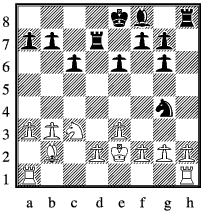
|
| RR v Peter Wood after 16 ... Ng4
|
4kb1r/pp1r1pp1/2p1p1p1/8/6n1/PPN1P3/1B1PKPPP/R6R w
By now I'm getting the impression this is not going to be one of my better congresses, this move inducing unnecessary panic. But if I had't wanted to face this move why not play h3 or even f3 last move instead of keeping the bishop out of b4? In the cool light of the analysis area I have no problem. At the board I did. Nxh2 is no big deal as I can play f3, and it will take him forever to extract his knight, which is pinned against the h8 rook.
17 something Rxh2, 18 Rxh2 Nxh2, 19 f3 is a similarly unattractive pawn win for him. So I should be concentrating on preventing any problems after Nxf2 from black - I can see that currently that is a concern. d3 or d4 solves that. But instead RR's attention is fixated on solving the h-pawn non-problem, even though he'd seen the danger to the f-pawn. Think most of the brain cells must have been on strike.
17 h3 Nxf2, 18 Rhf1 Nd3 19 Nd1 Nxb2 That's a relief. After Nc5 things would have looked really ugly.
20 Nxb2 Rh5, 21 e4 There are so many squares I don't want the rook swinging across to. Elect to stop the doubling on the d-file.
21 ... Rb5, 22 Rf3 Rc5, 23 Nc4 b5, 24 Ne3 Re5, 25 d3 Rc5
26 Kd2 Be7, 27 b4 Re5, 28 Ke2 Bf6, 29 Rc1 Rd6, 30 Rc2
Rcf1 with threats of Ng4 winning a pawn back clearly better, and considering that much of my play since dropping the pawn was based around keeping alive hopes of doing damage on the f-file should have been found and played.
30 ... Rh5 draw offered by black, and turned down. Understandable if I had doubled the rooks on the f-file, but do I truely believe I have anything going beyond my opponents lack of a wish to play for a win?
31 g4 Rh8, 32 Nf1 Bd4, 33 Nd2 Ke7, 34 Nb3 Bb6, 35 Nc5 e5
36 Rg3 g5, 37 Kf2 Rf6+, 38 Kg2 Rd8 39, Rc1 Bxc5 Another draw offer, this time accepted.
Rather like my round one opponent who I also outgraded, Peter seems oblivious of the principle of "don't offer draws to stronger opponents, as they'll only accept when you're clearly winning". Not that I'm suggesting that I have infallible capabilities of assessing the drawing possibilities in positions.
So disaster dodged, but little credit to RR for that.
comment on this article
Sat 30th: Hack Attack I
Following my narrow escape from disaster this morning, and my general lack of aggression to date, I was champing at the bit for an opportunity to launch an attack. The auspices for early violence were not good when David Lawrence elected to play a queen pawn opening
1 d4 Nf6, 2 Nf3 c5, 3 c3 e6, 4 e3 b6, 5 Bd3 Bb7
6 Nbd2 Qc7, 7 O-O Nc6
Expecting 8 Re1 d5 and a long drawn out battle, but instead David aids my development:
8 dxc5 Bxc5, 9 b4 Bd6 Be7 is surely the saner retreat, but in my current mood I can't resist lining up my pieces against h2.
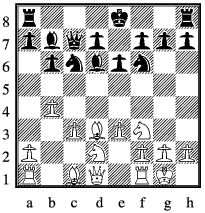
|
| David Lawrence v RR after 9 ... Bd6
|
10 Bb2 Ng4, 11 g3 h5 Will I be allowed h4 and an exchange sac?
12 Ne4 Do I retreat my bishop to f7 until I have kicked the knight away with f5? No, I think I'll keep moving forwards.
12 ... Nce5, 13 Nxd6+ Qxd6, 14 Be2 David unexpectedly declines to continue the exchanges in favour of doubling the defence of the knight. It is now a simple case of halving that defence:
14 ... Qxd1 0-1
comment on this article
Sun 31st: No Retreat
Round four, and a game against recent ECF CEO Andrew Farthing. We are hardly started and Andrew offers the option of an endgame. Seems favourable to me, but I know that in such situations finding a good plan is not always easy, particularly as I have a penchant for playing moves to keep the game progressing rather than having a proper thinking and planning session. Stll, here goes.
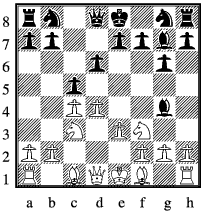
|
| RR v Andrew Farthing after 5 ... c5
|
rn1qk1nr/pp2ppbp/3p2p1/2p5/2PP2b1/2N1PN2/PP3PPP/R1BQKB1R
6 dxc5 Bxc3+, 7 bxc3 dxc5, 8 Qxd8+ Kxd8=, 9 Ne5 Be6
10 Ba3 f6, 11 O-O-O+ Castles with check is always enticing, but perhaps my king is better on the kingside, suggesting Nd3 here.
11 ... Kc7, 12 Nd3 b6, 13 Nf4 Bf7, 14 Be2 Nd7, 15 Nd5+ Kc8
16 e4 e6, 17 Ne3 Ne7, 18 f4 Kc7, 19 Kc2 Rad8, 20 Bc1 Rhf8
21 Rd3 Lots of sparring so far, but this is where I feel I should be doing better. My main claim to potential fame here is my bishop pair. Surely I have something better to do than set up rook exchanges.
21 ... Nb8, 22 Ng4 Rxd3, 23 Bxd3 Ng8, 24 h4 h5, 25 Ne3 Nh6
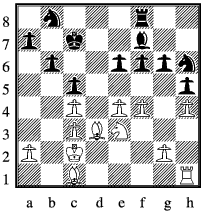
|
| RR v Andrew Farthing after 25 ... Nh6
|
1n3r2/p1k2b2/1p2pppn/2p4p/2P1PP1P/2PBN3/P1K3P1/2B4R w
It would be nice if I could get my knight into d5, so pushing the f-pawn is designed to allow this. That it also sets up the threat of a discovered attack on his knight is a bonus. Needless to say Andrew has other ideas.
26 f5 Ng4, 27 Nxg4 hxg4, 28 fxg6 Bxg6, 29 h5 I wondered later whether g3 and trying to conserve my passed pawn is better, but Fritz agrees with my choice at the time.
29 ... Bh7, 30 Bh6 A stronger player than RR might like the positions that can occur after e5 by white, but I confess to not even having consideed the move. If Black exchanges bishops the need to control the h-pawn limits black's future play, whilst pushing f5 takes the h7 bishop out of the game.
30 ... Rg8, 31 g3 Nd7, 32 Rf1 Kd8, 33 Kd2 Ke7, 34 Ke3 Not spotting the danger
34 ... Ne5, 35 Be2 so blindly keeps the light squared bishop on the board. Nice in principle, pity about
35 ... Nf7 as the dark squared bishop has no retreat.
36 Bf4 e5, 37 Rg1 exf4+, 38 gxf4
RR is only able to take down one pawn with his bishop, and despite extending the game for over twenty more moves (RR has never been good at resigning) Andrew never gave him a glimpse at getting back into the game. 0-1.
comment on this article
Sun 31st: Hack Attack II
Back on fifty percent then. Next up, black against Jamie Morgan. We join the game in the innocuous position shown, attained after 8 moves.
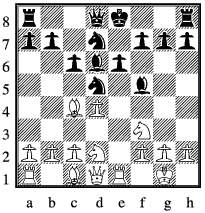
|
| Jamie Morgan v RR after 8 ... Nd7
|
r2qk2r/pp1n1ppp/2pbp3/3n1b2/2BP4/5N2/PPPN1PPP/R1BQR1K1 w
9 Ne4 Bxe4 Whilst it would be nice to retain the bishop pair, I feel that in most cramped positions swapping off pairs of minor pieces can reduce the chances of ones pieces getting in each others way.
10 Rxe4 N5f6 N7f6 is more natural, but I felt that this way I retained more control over e5.
11 Re1 Qa5 Played with intention of sweeping across to h5, though it seems unlikely I can do any damage there. Qc7 much more sensible. Indeed whilst Jamie was considering his reply I started panicking over a side effect of my choice of knight to move previously - he now has the option of
12 Bxe6 fxe6, 13 Rxe6+ Be7, 14 Qe2 and considerable black discomfort.
12 Bd2 (phew!, wipes sweat from forehead) Qc7
13 h3 O-O-O (0-0 more solid, but I've had enough draws)
14 Bf1 h5, 15 Qe2 Ng4
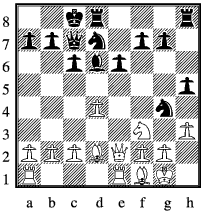
|
| Jamie Morgan v RR after 15 ... Ng4
|
2kr3r/ppqn1pp1/2pbp3/7p/3P2n1/5N1P/PPPBWPP1/R3RBK1 w
Were it not for my g4 knight we would still be in hostilities at arms length mode. As it is I have an aggressive looking position with h2 in my sights, but I think he can safely ignore me and get on with a queenside expansion, for how do I add bite to my intended attack?
16 hxg4 hxg4, 17 Ne5 f6 Jamie goes for a line in which we effectively exchange knights and I end up with weaker pawns and he a slightly more exposed king, or so I assume, but ...
18 Nxd7 You can't play that and live.
18 ... Bh2+, 19 Kh1 Bg1+ 0-1 (20 Kxg1 Qh2#)
So that is two afternoons on the trot that I've made minor threats against h2 and my opponents have then contributed to their own downfall. It's a weird feeling as despite it always being nice to chalk up a win there is also a feeling of been cheated out of having a good game.
comment on this article


















